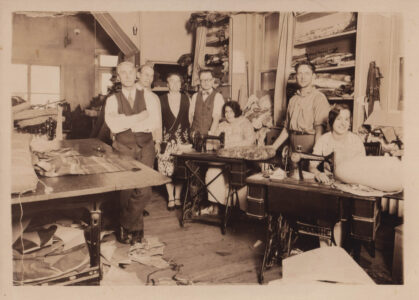Women of 1776: Giving birth to a nation
Part 1 of 2
Think of the Revolutionary War, and the phrase “Founding Fathers” quickly comes to mind along with a group of now bigger-than-life individuals starting with George Washington. With few exceptions, the cast of acknowledged American Revolution luminaries is all male. This is hardly surprising given that opportunities for women in colonial American were severely limited, for at least two reasons.
First, via the legal doctrine of “couverture,” upon marriage all that a woman owned — including the clothing on her back — was now the property of her husband, and she could neither buy nor sell property, nor engage in legal contracts.
Couverture is the legal fiction that with marriage, a husband and wife are one person. The husband-half of this lone individual has the legal and moral authority to make family decisions. One of these decisions was to keep a spouse almost continually pregnant, and women of that period routinely gave birth every 24 months during their marital childbearing years.
Second, because colonial America was an agricultural society, the vast majority of women were burdened with a monumental workload and scant possibilities for schooling. As historian Carol Berkin states, the domain of women was the household, the garden, the henhouse and turning raw materials into meals, clothing, candles and soap. A woman’s lot was having and raising children, and never-ending house and farm-related work.
These constraints not withstanding, women from every socio-economic class would contribute to the defeat of the British and establishment of a new republic. Starting with the Stamp Act of 1765, middle-class women led boycotts of British manufactured goods — the first concerted acts of colonial resistance.
These boycotts had an “immediate and powerful effect” as women were the chief purchasers of British goods. Parliament could (and did) ignore the petitions of male legislatures across the colonies, but they could not ignore the pressures exerted on them by British manufacturers who saw their colonial sales plummet. Parliament relied heavily on taxes from the profits of manufactured goods to pay for costly wars with France. Increasing that burden on an already highly taxed (and angry) British and colonial public to make up the shortfall was risky. Women were also instrumental in boycotting tea after taxes placed on that commodity via the Tea Act of 1773.
In 1765, The Daughters of Liberty was established, an organization that not only boycotted British goods but started the drive for colonial women to produce their own clothing — “homespun.” Clergymen organized “spinning bees” where women gathered and spun wool that would be used for clothing, and later uniforms and blankets for soldiers. In 1769 the Boston Evening Post wrote that with their “industry and frugality,” women were demonstrating how “greatly they are contributing to bring about the political salvation of a whole continent.”
“Camp followers” — women who traveled with armies — were an integral part of both the British and Continental forces. Historians estimate that between 3 and 10 percent of Patriot armies were females. Some were wives and girlfriends of soldiers. Continental Army officers quickly learned that if they prohibited these women from traveling with armies, they faced a significant problem, as George Washington noted in a letter to Pennsylvania merchant and war financier Robert Morris: “I am obliged to give Provisions to the extra Women in these regiments, or lose by Desertion, perhaps to the enemy, some of the oldest and best Soldiers in the Service.”
According to Carol Berkin, the majority of camp followers were desperate women driven to the army by war-caused poverty, the death of husband, fear of starvation, loneliness, and fear of rape and death at the hands of enemy soldiers. The food they received and living conditions were meager, Berkin notes, but “preferable to no food or shelter at all.” To earn their keep, these women served as cooks, washerwomen, seamstresses, nurses, scavengers for food and supplies, tenders of livestock, sexual partners and, on occasion, as soldiers and spies. Overworked and underfed, one observer described camp followers as “beasts of burden.”
Many camp followers were prostitutes who found no shortage of customers among young soldiers, and commanders of both armies did their best to regulate the presence of these women. Morality was not the issue. Rather, outbreaks of venereal diseases could significantly reduce the number of combat-fit troops.
As the fighting escalated, both British and American commanders realized camp followers were indispensable to their armies, yet a major headache as well. In 1777, George Washington wrote, “The multitude of women in particular, especially those who are pregnant, or have children are a clog upon every movement. The Commander in Chief recommends to the officers to use every reasonable method to get rid of all such as are not absolutely necessary.”
By “absolutely necessary” Washington meant washerwomen and those who cared for the sick and wounded. The former not only washed soldiers’ clothing but kept the camps as clean as possible under difficult conditions. Berkin notes that filthy clothing and unsanitary camps were breeding grounds for a host of diseases including typhus, dysentery and respiratory illnesses. The workload was usually staggering as, for example, New York’s 3rd Regiment allotted only four washerwomen for 435 men.
The Continental Army preferred female to male nurses for two reasons: first, because nursing the sick was traditionally a female role, and second, because every female nurse meant one more man was available to fight. Nursing was hazardous work as caregivers were exposed to camp diseases — including smallpox. Berkin notes that for their “endless rounds” of cleaning, emptying chamber pots and continually disinfecting sick wards with vinegar, female nurses were paid about one-tenth of what surgeons and male attendants earned.
There are few documented cases of women who dressed as men and passed for male soldiers during the war, and the actual number of women who employed this strategy is unknown. Carol Berkin states that a woman’s motivation to pass as a male made the difference between the admiration or contempt of enlisted men and officers. Women who masqueraded as male soldiers to be with a husband, father or brother were admired while those who joined as men to secure an enlistment bonus were typically scorned.
Women who risked injury and death during a fight were praised, including those who brought water to thirsty men on the battlefield and hauled water to cool off hot cannon barrels so the guns might continue to fire. These women were often referred to by the generic term “Molly Pitcher.” Berkin is emphatic in stating a specific water-carrying woman named Molly Pitcher “did not exist.”
The importance of women in the struggle for independence may be little known to us, but it was not lost on the British of that era, including General Lord Cornwallis, who stated, “We may destroy all the men in America, and we shall still have all we can do to defeat the women.”
—
George J. Bryjak lives in Bloomingdale, retired after 24 years of teaching sociology at the University of San Diego. A list of sources will accompany part 2 of this commentary tomorrow.



